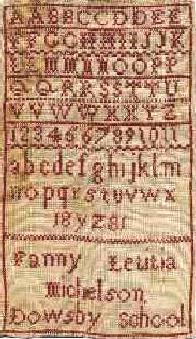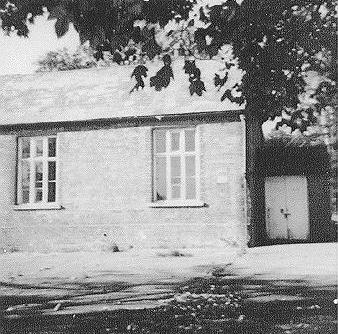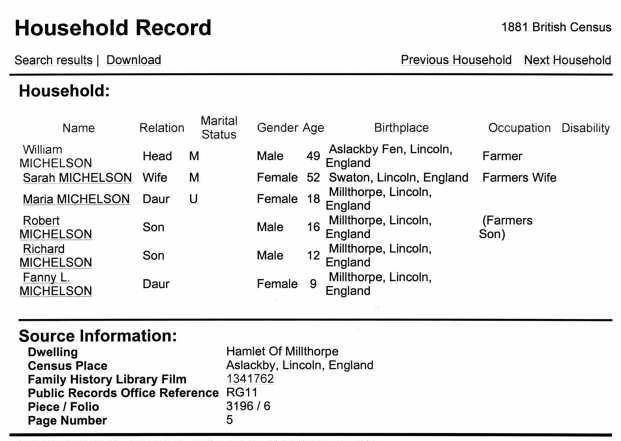|
The village school and
the 1881 sampler
|
 |
 |
|
The wool and linen sampler stitched by Fanny
Michelson in 1881 and the school she attended, now converted into a
private home. |
In centuries past, children were
meant to be seen and not heard and so parents, governesses and teachers
devised various methods of good works to keep them occupied. For the
girls, sewing was high on the list of activities that could be pursued in
silence and at the same time, taught a craft that would be useful in later
life.
The sampler came to be regarded as an essential part of a young woman’s
education because it provided a record of all the stitches and patterns
that a housewife would require and as pictures of houses, churches, trees
and flowers were added, they became works of art when finished in silk
thread on linen. Among the more common inscriptions are prayers, moral
maximums and biblical texts, often showing a preoccupation with death and
misery, although less depressing subjects can also be found such as those
depicting maps and major events although these are particularly rare
because of their value as social or historical documents.
The most beautiful specimens of original sampler work that have survived
belong to the 17th century and in consequence are rarely found outside
museums although the 18th century did see some fine examples which are
highly collectable. In later years, they were framed for their artistic
value and many were indeed triumphs of decorative needlework which are
highly prized by connoisseurs and collectors. The fashion for using Indian
cotton resulted in many designs with bright floral patterns although the
variety of stitches had decreased by the end of the 18th century when
cross-stitch alone appears to have held the field and this became known as
the sampler stitch.
Sampler making was a common subject on the curriculum of the early state
schools of the 19th century and, with typical Victorian sense, alphabets
and numerals were usually the prescribed patterns in order that children
would learn two subjects at once. Because of the large number of
participants, materials were necessarily cheaper and brightly coloured
wools were employed on meshed canvas and more ambitious designs such as
landscapes and animals, often cleverly shaded, were made possible by the
use of coloured embroidery charts, although these niceties are usually
absent in classroom designs which tend to be more mundane.
The inscriptions on samplers are a literature in themselves and an
intriguing record of the precepts of child education during that period.
One such example from the Bourne area has been acquired by Jacqueline
Holdsworth of Guildford in Surrey, who bought it from an antiques shop near
Hanover in Germany where the owner said that he had picked it up about 15
years before at a street market in England. “I suppose I bought it because
it was in the wrong country and demanded to be brought home”, said
Jacqueline.
The sampler was the work of Fanny Letitia Michelson, a pupil attending the
village school at Dowsby in 1881. Education, as elsewhere in England at
that time, was entirely at the behest of local philanthropists and it was
the Burrell family of Dowsby Hall who founded and maintained a parish
school in the village during the 17th century when classes were held in
the vestry of St Andrew’s Church, a room that was later enlarged for this
purpose. This was replaced by an endowed or elementary school, built of
red brick and blue slate on land near the church in 1864 with room for 65
children although attendance was usually far less. The average number at
lessons in 1885 was only 42 but this had risen to 53 by the end of the
century. John Robert Holmes was headmaster and he was also the parish
clerk and the local collector of taxes and he was still in charge in 1904
although by that time the rector, the Rev Thomasin Albert Stoodley, had
taken over as parish clerk.
The school was financed with money raised by a local rate, a government
grant and an annual endowment of £10 from the estates of local landowners
and continued in use until it closed under the government re-organisation
of education in 1976 when the building was sold and it has since been
rebuilt as a private home. The village was also sufficiently prosperous at
that time to support a mill that survived into the 20th century, as well
as a boot and shoe maker, a grocer and beer retailer, but today all have
closed and there are no shops or services apart from a telephone kiosk.
Fanny's sampler contains the
letters of the alphabet in capitals and lower case, the numbers from 1 to
11, her name with the date 1881, and a few lines in cross-stitch. This is a
simple example of the art, a relic of elementary education during
Victorian times, worked in red wool and canvas rather than silk and linen,
and it has not weathered the years particularly well. But once its
antecedents are known, it becomes an interesting example of school work in
the late 19th century, one that Jacqueline describes as “a simple sampler,
not over-embellished, just plain and honest”, and although she does not
say how much she paid for it, in the right sale on a good day it would be
quite likely to fetch £20-£30. Whatever would Fanny have thought had she
known that her work would one day be that valuable?
Research has revealed that Fanny was the
nine-year-old daughter of a farmer, William Michelson, aged 49, and his
wife Sarah, aged 52, who lived at nearby Milthorpe [also spelled
Millthorpe] and they had three other children, an 18-year-old daughter
Maria and sons Robert, aged 16, and Richard, aged 12. Milthorpe is not
marked on many maps because it is little more than a hamlet with a
population of 70 in 1881. It is almost a mile to the north of Dowsby and
in the absence of motor cars and public transport, we must assume that
Fanny had to walk to and from school every day along a country road or
perhaps taking a short cut by following farm tracks across the fields.
William Michelson was an established farmer
with land in Aslackby fen and is listed in Kelly’s Directory for 1876 and
again in 1886 although by 1904, his son Robert had taken over but we have
no idea what happened to Fanny after her schooldays, the most likely
eventuality being marriage or domestic service.
Michelson is a name that occurs frequently in the social history of the Bourne
area and descendants of Fanny’s family may still be alive. One of her ancestors
is almost certainly Robert Michelson who managed the Dowsby Decoy from
1763 to 1783. He and his wife Isabella lie beneath a pair of fine slate
headstones in the churchyard outside the south porch.
WRITTEN MARCH 2004
|
The Michelson family of Milthorpe as detailed in this
extract from
the 1881 census provided by the Public Records Office |
|
 |
See also Milthorpe
Return to Dowsby

Go to:
Main Index Villages
Index
|


